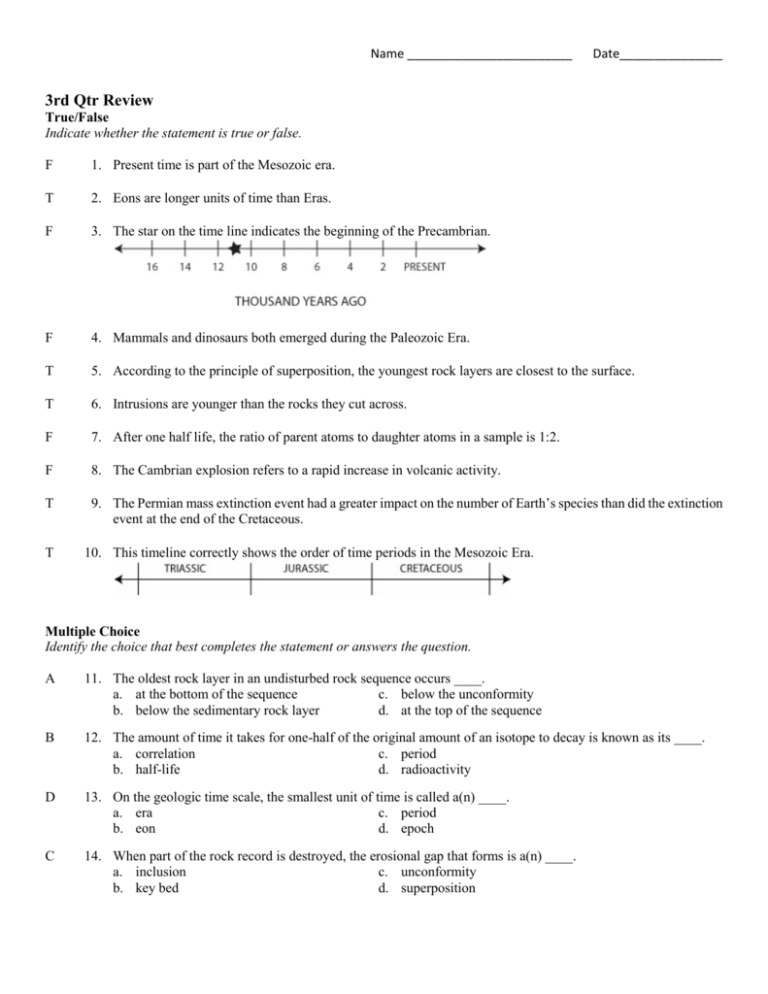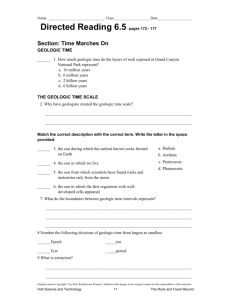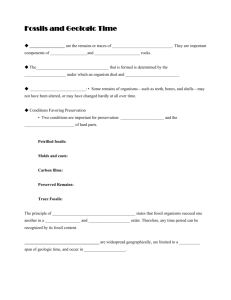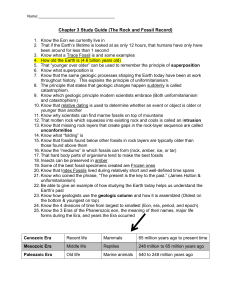3rd Qtr Review
advertisement

Name ________________________ Date_______________ 3rd Qtr Review True/False Indicate whether the statement is true or false. F 1. Present time is part of the Mesozoic era. T 2. Eons are longer units of time than Eras. F 3. The star on the time line indicates the beginning of the Precambrian. F 4. Mammals and dinosaurs both emerged during the Paleozoic Era. T 5. According to the principle of superposition, the youngest rock layers are closest to the surface. T 6. Intrusions are younger than the rocks they cut across. F 7. After one half life, the ratio of parent atoms to daughter atoms in a sample is 1:2. F 8. The Cambrian explosion refers to a rapid increase in volcanic activity. T 9. The Permian mass extinction event had a greater impact on the number of Earth’s species than did the extinction event at the end of the Cretaceous. T 10. This timeline correctly shows the order of time periods in the Mesozoic Era. Multiple Choice Identify the choice that best completes the statement or answers the question. A 11. The oldest rock layer in an undisturbed rock sequence occurs ____. a. at the bottom of the sequence c. below the unconformity b. below the sedimentary rock layer d. at the top of the sequence B 12. The amount of time it takes for one-half of the original amount of an isotope to decay is known as its ____. a. correlation c. period b. half-life d. radioactivity D 13. On the geologic time scale, the smallest unit of time is called a(n) ____. a. era c. period b. eon d. epoch C 14. When part of the rock record is destroyed, the erosional gap that forms is a(n) ____. a. inclusion c. unconformity b. key bed d. superposition Name ________________________ Date_______________ A 15. Index fossils are useful to geologists if the fossils ____. a. have lived over a short period of time b. are not easily recognized c. are not widely distributed geographically d. are scarce D 16. What are fossil insects preserved in hardened tree sap called? a. trace fossils c. coprolites b. gastroliths d. amber A 17. Molds, casts, coprolites, and petrified wood are all example of ____. a. fossils c. unconformities b. radioactive isotopes d. disconformities D 18. Which of the following lists the units of geologic time in order from shortest to longest? a. era, eon, period, epoch c. eon, era, period, epoch b. epoch, eon, period, era d. epoch, period, era, eon A 19. An example of a fossil with original preservation includes a(n) ____. a. insect imbedded in amber c. dinosaur footprint b. coprolite d. mold of a fish skeleton D 20. An example of a fossil with altered hard parts includes ____. a. a mummified human body c. a saber-toothed cat in tar b. a gastrolith d. petrified wood B 21. An example of a trace fossil includes a ____. a. cast of a clam b. worm trail B 22. What is the correct label for “C” on the diagram? a. Paleogene b. Paleozoic C c. mud crack d. raindrop impression c. Permian d. Paleocene 23. The shaded area of which graph represents the percentage of geologic time that is part of the Precambrian? a. A b. B c. C d. D Name ________________________ D 24. The principle of superposition can be used to determine a. b. c. d. B Date_______________ . the actual age of these rock layers the relative densities of these rock layers the actual temperatures of these rock layers the relative age of these rock layers 25. Using the graph, determine the half-life of thorium-232. a. 7 billion years b. 14 billion years c. 28 billion years d. 35 billion years B 26. Seed plants that lived during the Carboniferous impact life on Earth today because________. a. they are the ancestors of all plant life on Earth b. their remains formed coal, which is an important resource c. they produced fossils that are used to date many geologic events d. their presence caused oxygen levels to drop, allowing animals to evolve A 27. Which point on the timeline best indicates the time when the Permian Mass Extinction happened? a. A b. B c. C d. D Name ________________________ Date_______________ Completion Complete each statement using the words listed below for questoins 29-36 -Mold -Permineralization -Amber -Correlation -Superposition -Geologic time scale -Cast -Cross-cutting relationships 28. The principle of SUPERPOSITION states that, in an undisturbed sequence, the oldest rocks are at the bottom of the sequence and successive layers are younger than those below them. 29. In the process of PERMINERALIZALTION, pore spaces within an organism’s shell are filled in with mineral substances. 30. Fossil insects can be found imbedded in AMBER, the hardened sap of prehistoric trees. 31. A(n) CAST forms when the hollowed-out impression of a fossil organism becomes filled with minerals or sediment. 32. The GEOTIME SCALE divides Earth’s history into units from its origin to the present. 33. When the original parts of an organism in a sedimentary rock are weathered and eroded, a hollowed-out impression called a(n) MOLD forms. 34. You can use the principle of CROSS-CUTTING to infer that a fault or an intrusion is younger than the rock it cuts across. 35. The matching of rock layers from one geographic area with those of another area is known as CORRELATION. Short Answer 36. Compare and contrast eras and periods. Both are units of time on the geologic time scale. Eras are bigger sections of time than periods. Periods make up eras. 37. Explain the principle of uniformitarianism. Things that happen today must have happened in the past. “Present is the key to the past.” 38. Contrast relative-age dating and absolute-age dating. Relative – putting things in order. Absolute – an exact date. Name ________________________ Date_______________ In a laboratory, you produce a quantity of the radioactive isotope thorium-234. Over the course of several weeks, the unstable isotope decays, and you measure the amount of thorium-234 remaining in the sample. You obtain the following data. Days Elapsed Grams of Thorium-234 Remaining 0 16 12 11 24 8 36 6 40. Use the data above. What is the half-life of thorium-234. (Use Lables) 24 days 41. Use the data to complete the graph below. Draw a line graph X X X X 42. Predict how much thorium-234 will remains after 2 half-lives. 4 grams Name ________________________ Date_______________ Refer to the picture below and put the following events in the order in which they occurred, starting with 1 as the oldest. 43. J is deposited. 10 44. M intrudes and crystallizes. 5 45. Q is deposited. 1 46. I is deposited. 9 47. N is deposited. 3 48. L is deposited. 4 49. H is deposited. 8 50. P intrudes and crystallizes. 6 51. J is eroded. 11 52. L, M, N, O, P , and Q are uplifted and eroded. 7 53. K is deposited. 12 54. O is deposited. 2 Name ________________________ 55.Circle the eon, era, period, and epoch in which you live. Eon Phanerozoic Era Cenozoic Period Quaternary Tertiary Mesozoic Paleozoic Epoch Holocene Pleistocene Pliocene Miocene Oligocene Eocene Paleocene Cretaceous Jurassic Triassic Permian Carboniferous Devonian Silurian Ordovician Cambrian Proterozoic Archean Hadean 56. Fill in the characteristics of the Cenozoic era that you would include in the chart? Age of Mammals Rise of Man Date_______________ Name ________________________ Date_______________ The table lists commonly used radioactive isotopes and their half-lives. Study the table and answer the following questions. Half-Lives of Selected Radioactive Isotopes Radioactive Isotope Approximate Half-Life Decay Product Rubidium-87 48.6 billion years Strontium-87 Thorium-232 14.0 billion years Lead-208 Potassium-40 8.4 billion years Argon-40 Uranium-238 4.5 billion years Lead-206 Uranium-235 0.7 billion years Lead-207 Carbon-14 5730 years Nitrogen-14 57. Which isotope has the longest half-life? Rubidium-87 58. Which stable element does Uranium-238 decay into? Lead-206 59. After 28 billion years, what percentage of an original sample of Thorium-232 will remain undecayed? 25% C 1. What planet is the largest in our solar system? a. Earth b. Neptune c. Jupiter d. Saturn C 2. Which of the following best describes the Moon and the Earth’s movements? a. The Moon rotates around Earth c. The Moon Revolves around the Earth b. The Earth Revolves around the Moon d. The Earth rotates around the Moon B 3. In Which of the following is the smallest planet? a. Jupiter c. Mars b. Mercury d. Venus Name ________________________ A 4. Which phase is the Moon in when the Earth, Sun, and Moon are in the positions shown in the diagram? a. new moon b. full moon A Date_______________ c. waxing crescent d. waning gibbous 5. What phase would we see from earth when the Moon is at positions A? a. 3rd Quarter b. New Moon c. Waxing Gibbous d. Full Moon A 6. Which of the following planet has the longest year? (Longest time to go around the Sun)____. a. Neptune c. Saturn b. Mercury d. Moon A 7. When the moon is “waxing” what is happening to it. a. growing c. Getting clean b. shrinking d. Getting smaller B 8. What percentage of the moon is always lit up by the sun? a. 25% c. 75% b. 50% d. Depends on the phase of the moon Name ________________________ D A 9. What takes about one month to occur ____. a. Moons Revolution around the sun b. Moons rotation around earth Date_______________ c. Moons rotation around the sun d. Moons revolution around earth 10. Do we always see the same side of the moon? a. Yes b. No List the Planets in order starting with the closest to the Sun SUN 1 Mercury 2 Venus 3 Earth 4 Mars 5 Jupiter 6 Saturn 7 Uranus 8 Neptune Pluto (Dwarf planet)








